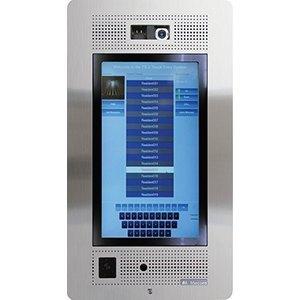
With so many styles and features available, modern intercom systems allow for seamless integration into just about any environment. Making the right choice for your building—whether an apartment, condo, hospital or other facility with access control needs—is easier when you know which questions to ask.
Does your intercom need to be integrated with an access control system?
Today’s intercoms can do more than open the lines of communication—they can open doors (literally) as part of a building’s access control system. Integration enables convenient monitoring and management of who gains entry, reducing the burden on security staff while boosting occupant and visitor peace of mind.
Some intercom systems even serve as a primary access control device. Equipped with a wide range of advanced features, these units can be used to control existing entry systems such as electric door strikes, magnetic locks and door and gate operators. They can also integrate with CCTV cameras to support your video surveillance needs.
If your facility uses an access card system, you may find that an intercom with a built-in card reader offers the best solution by enhancing security while saving space.
To ensure your new intercom can be properly integrated with an access control system, it’s a good idea to speak to a professional first. This will ensure the technologies are compatible and that you’re getting the most out of both systems.
Do you need video capabilities?
For added convenience, control and security, a video intercom is a good option. Some intercom systems on the market today come with a built-in camera to stream video to the suite, letting occupants establish visual identification before deciding whether to provide access.
Wired video intercoms deliver reliable, consistent images and audio free from the kind of interference that can be experienced with wireless models. To get the best picture and performance, look for a model with HD colour video.
Some offer added features such as a pan, zoom and tilt camera, and picture memory capable of storing hundreds of images.
Where will the unit be placed?
One of the more practical questions to consider when choosing an intercom system is where the unit will reside. Fortunately, many systems offer multiple mounting options for convenient installation. The most common of these are flush-mounted, recessed, gooseneck (extending outward at a near-90-degree angle) and standalone kiosk.
Hooded units offer built-in protection from rain, making them a popular choice for outdoor applications such as the entrance to apartment buildings, industrial facilities or gated communities.
Due to their position away from the building, outdoor intercom systems are generally more susceptible to tampering. For these applications you might want to consider added protective features including a rugged enclosure, tamper resistant speaker and provision for a postal lock.
Where space is limited, a specially designed slim intercom system will ensure a good fit while still allowing convenient access to the interface.
Of course, outdoor units also have to perform under a wide variety of lighting and visibility conditions. LCD displays, while ideal for indoor use, aren’t necessarily the best option for outdoor applications, especially where lighting can’t be tightly controlled. In these cases, an electroluminescent (EL) display will provide a consistently high-quality picture.
How many people will it serve?
Right away, the size of your facility will help narrow down the list of potential intercom systems. Some are designed specifically to handle the needs of larger buildings such as high-rise apartments and condominiums, while others work best on a smaller scale.

The Mircom TX3-Touch-F22 is a flush-mounted intercom system with a 22″ full colour touchscreen display for attractive styling and a seamless user experience.
In addition to comparing the name and access-code capacities of each system, consider the user experience offered. How easy it will be to browse or search for a name? Is information displayed clearly, even for those with poor eyesight?
Asking yourself these kinds of questions will help you choose not only the most appropriate product, but the one that visitors and occupants will find most enjoyable.
Ideally you’ll be able to see the intercom system in action before purchasing it, whether experiencing it firsthand, watching a demo or viewing images of the interface.
What extra features or options do you need?
Beyond a long list of standard features, many of today’s intercom systems come with an impressive array of options and supporting features. These enhance everything from security and convenience to cosmetic concerns such as the style of the screen interface.
Some of the many features you might encounter while comparing intercom systems include:
- Multi-language support with ability to add translations
- Hands-free capability
- Integrated advertising module to generate revenue
- Programmable welcome message
- Multiple programming options, including remotely with a phone or computer
- Configurable themes, screens and layouts for customizable design
- Network connectivity
- Panic alarm switches
- Magnetic tamper switch
- Email feature for private messages between guests and occupants
- Elevator restriction capability
- Help button to activate video instruction
For help finding the right balance between features and cost, you can talk to a product specialist at ABC Security. We’ll guide you through the process by explaining your options and how they match up with the short- and long-term goals you’ve set for your facility.


 blog
blog